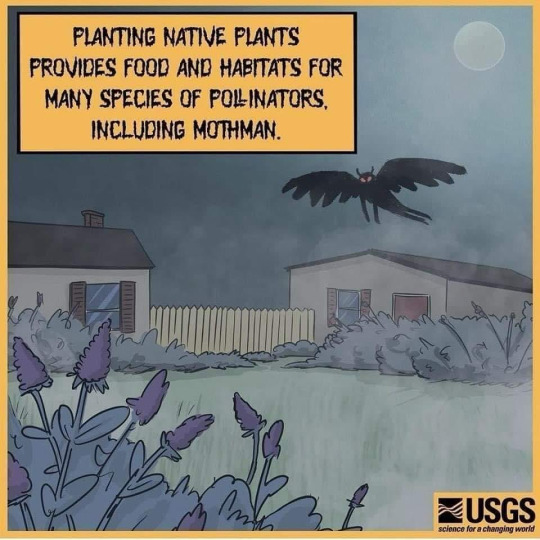Text

Happy World Dracula Day!
2 notes
·
View notes
Text
The Dark History Magdalene Laundries

I believe that remembering dark times in history is important so we recognize when similar situations are proposed. So, today I will share one of these dark histories.
⚠️Do note that it is a story with abuse, imprisonment, and more. I feel like this post will be particularly triggering to residential school survivors.
I will try to keep this post brief and fairly censored, while providing videos with more information.
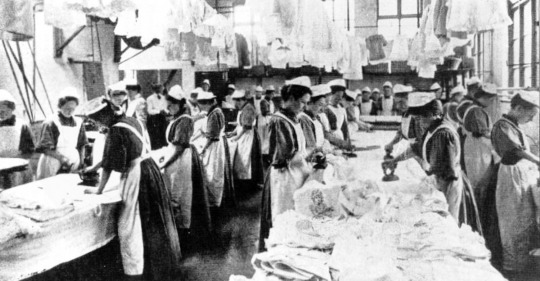
Magdalene Laundries (also called Magdalene Asylums and Magdalene Institutions) were institutions primarily run by the Roman Catholic Church. These institutions could be found in the United Kingdom, Ireland, Sweden, Canada, the USA, and Australia. The ones in Ireland are regarded as the most notorious.
The people confined to these institutions were “fallen women,” which meant any women who were outside of what society deemed appropriate.
According to survivors, you might find yourself in a laundry if you…
Are suspected of being a sex worker
Got pregnant outside of marriage
Got pregnant from an affair
Are an orphan
Ran away from your abusive husband
Have a mother deemed unsuitable to raise you
Have a mental illness
Are deemed too flirtatious
Are the victim of assault
Have an abusive father
Have struggling parents who want one less mouth to feed
Have a mother who remarried and her new husband does not want you
And some were sent with no known reason at all
“A "voluntary" committal was the label given to any woman surrendered by family, a doctor, her employer, the police, or a social worker.” Owlcation
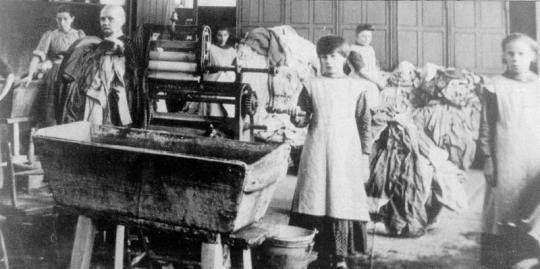
The women were a source of free labour, primarily through a laundry business(hence the name). Little care was given to these women and children, and survivors report many levels of abuse.
"Ireland's first mother and baby home, at Bessborough, in Cork, had an even worse infant mortality rate of around 82 percent: In the year ending March 31, 1944, 124 children were born or admitted there, and 102 died." NBC News
Only some deaths were reported, and the number of remains found in mass graves in Ireland is around 1000.
Babies that survived would be given to new families.
Some women would be stuck in the institutions for their entire lives. An estimated 30,000 women were victims of these institutions in Ireland alone.
For a long time, the rumours were that the laundries were “only” for prostitutes. Now the rumours say that only those in Ireland were harmful. However, locations elsewhere in the world, such as Australia, Canada, and the USA, also have stories of abuse in the forced-labour institutions.
youtube
youtube
0 notes
Text
May Day Celebrations at Elstow (1939)
youtube
“L/S’s May Day celebrations in Elstow in Bedfordshire. L/S's of the May queen's procession. VL/S of the May Queen being crowned. L/S's of children dancing around the maypole. Several more shots of the celebrations in progress watched by large crowds. FILM ID:1009.04”
3 notes
·
View notes
Text

Girls from Liberton School wash their faces in the dew on Arthur's Seat on May Day 1963
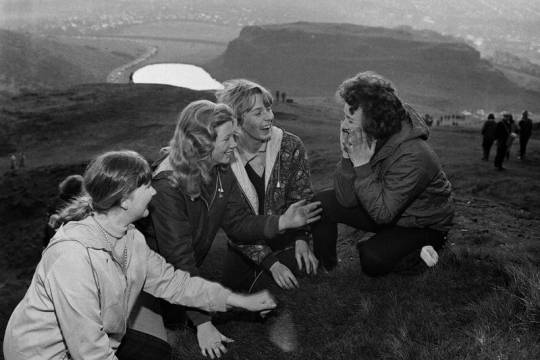
Four girls wash their faces in the morning dew as the sun comes up on May Day morning on Arthur's Seat in 1965.
166 notes
·
View notes
Text
Scottish Historical Beltane/May Day

Bealtiunn (Beltane) is a cross-quarter day, meaning it is approximately half-way between a equinox and solstice. Due to this, it was one of the four main fire festivals of the year, and a time when the veil between our world and the otherworld was said to thin. This was thought to allow fairies in particular to be extra dangerous.
"The first–called “Beltaine” in Ireland, “Bealtiunn” in Scotland, “Shenn da Boaldyn” in the Isle of Man, and “Galan-Mai” (the Calends of May) in Wales–celebrates the waking of the earth from her winter sleep, and the renewal of warmth, life, and vegetation. "
Celtic Myth and Legend by Charles Squire[1905]
It was once a huge celebration that may even last a whole week, but it also served as a marker for when to start farming practices. For example, it marked when to sow barley, or put cattle out to graze.
Due to the pagan origins of the day, opposition towards May Day celebrations was not uncommon, and eventually led to it’s fall in popularity.
"In 1696 a number of persons were tried before the Kirk Session of Aberdeen and censured for celebrating May Day morning."
Primitive Beliefs in the North-East of Scotland
For customs click "keep reading." ⬇

May Pole

May Poles are a pole that was raised on beltane and raised with a crown of flowers on the top.
“The May Pole is up ,
Now give me the cup,
I’ll drink to the garlands around it,
But first unto those
Whose hands did compose
The glory of flowers that crown’d it.”
“Faiths and Folklore: Volume 2,” By William Carew Hazlitt (1905)
It was also often decorated with flowers, leafy garland, ribbons, and more. Thought to be a fertility symbolism, with it came the queen and king of May.
"We may infer,’ says Frazer, ‘that our rude forefathers personified the powers of vegetation as male and female and attempted, on the principle of homeopathic or sympathetic magic, to quicken the growth of trees and plants by representing the marriage of the sylvan deities in the persons of a King and Queen of May, a Whitsun Bridegroom and Bride, and so forth. Such representations… were charms intended to make the woods to grow green, the fresh grass to sprout, and the flowers to blow. And it was natural to suppose that the more closely the mock marriage of the leaf-clad or flower-clad mummers aped the real marriage of the woodland sprites, the more effective would be the charm."
Silver Bough 2 By F. Marian McNeill

Dressing the Home
Due to the veil being thinner, all sorts of supernatural dangers were thought to be at play. To counteract that, people dressed their homes in flowers, greenery, and other decorations.
“To counteract their evil power pieces of the rowan-tree and woodbine, chiefly of rowan-tree, were placed over the byre doors, and fires were kindled by every farmer and cottar. “
“Notes on The Folk-Lore of the North-East of Scotland,” By Walter Gregor (1881)
It was not just leafy garlands, however, but flowers as well.
"In the country west of Glasgow it is still remembered how once the houses were adorned with flowers and branches on the first of May”
“Essays in the study of Folk-Songs,” by Countess Martinengo-Cesaresco (1886)

May-Dew
The very first thing many girls wanted to do in the morning was race out to collect the morning dew.
“COUNTY OF EDINBURGH. At Edinburgh about four o’clock in the morning there is an unusual stir ; and a hurrying of gay throngs through the King’s Park to Arthur’s Seat to collect the May-dew.”
“British Popular Customs, Present and Past; Illustrating the Social and Domestic,” by T. F. Thiselton-Dyer (1876)
Depending on the area, where you would collect it from may change. It might be from a specific hill of grass or a specific type of trees.
This liquid, called may-dew, was said to have curative or beautifying powers.
"It was long an article of popular faith in Eastern and Western Europe , that a maiden , washing herself with dew from the hawthorn on the first day of May at daybreak , would preserve her beauty for ever, the operation being of course annually repeated.”
“Faiths and Folklore: Volume 2,” By William Carew Hazlitt (1905)
“Till quite lately there was a belief in some parts of England that a weakly child would be made strong by being drawn over dewy grass on the morning in question. To effect a complete cure, the treatment had to be repeated on the two following mornings.”
“Folklore of Scottish Lochs and Springs,” by James M. Mackinlay (1893)
However, the dew inside a fairy ring would have the opposite intended effect.
“May-dew from the grass was equally efficacious, except when gathered from within a fairy ring, as the fairies would in that case counteract the influence of the charm.”
“Folklore of Scottish Lochs and Springs,” by James M. Mackinlay (1893)

Egg Rolling
Egg rolling, something we trend to associate with Easter, was occasionally practiced on Beltane. Colorfully decorated eggs would be rolled down a hill.
"Egg rolling, something we trend to associate with Easter, was occasionally practiced on Beltane. Colorfully decorated eggs would be rolled down a hill."
“The Folk-lore Journal, Volume 7; Volume 24,” By Folklore Society (Great Britain)

Visiting Healing Wells
“Besides saining with fire, there was also saining with water, and Beltane was the great season for visiting “magic” or “holy” wells. The custom has by no means died out, the most notable survival being the annual “pilgrimage” to the Cloutie Well on Culloden Moor, near Inverness, which described elsewhere.”
The silver bough vol 2
Visits to healing wells was a common occurrence for people on May day.
Two centuries earlier an attempt was made by the kirk-session of Perth to put a stop to an annual gathering on May Day at a cave in the face of Kinnoul hill adjoining the town. This cave was called the Dragon Hole, and was the scene of ancient rites of a superstitious nature. Other illustrations might be selected from the Folklore of May Day, but those given above show that the season was held in much superstitious regard. Accordingly, we need not be surprised that well-worship took its place among the rites of May Day, and of May Month also, since the whole of May was deemed a charmed time.
"Folklore of Scottish Lochs and Springs" (in regards to Hone’s Every-Day Book on Edinburgh)

Mock Human Sacrifice
During the quarter days, quarter cakes were eaten ritually. For Beltane, this was called bannoach Bealltain or Beltane Cakes.
"Beltane cakes were also made at Keith, being baked the day before. The upper side was watered with a batter, made of whisked eggs, milk, and oatmeal. Struan Michaels and Beltane bannocks were prepared in Ross-shire down to the close of the nineteenth century."
“Primitive Beliefs in the North-East of Scotland,” by Joseph McKenzie McPherson (1929)
Exactly how they were eaten would depend on the area.
"In Caithness, within the last seventy years, each family in the neighbourhood of Watten carried bread and cheese to the top of a hill called Heathercrow and left it there. After sunrise, the herds might take away the spoil for their own homes."
“Primitive Beliefs in the North-East of Scotland,” by Joseph McKenzie McPherson (1929)
For some, it involved a mock human sacrifice.
The boys would go out, kindle a fire, have a meal, and sing and dance around it for fun. After, someone would produce a bannock and divide it for the group.
"Towards the close of the entertainment, the person who officiated as master of the feast produced a large cake baked with eggs and scalloped round the edge, called am bonnach bea-tine—i.e., the Beltane cake. It was divided into a number of pieces, and distributed in great form to the company.John Ramsay, laird of Ochtertyre, near Crieff, the patron of Burns and the friend of Sir Walter Scott."
The Golden Bough by Sir James George Frazer[1922]
Chapter 62. The Fire-Festivals of Europe
One piece stood out from the others, and the person who picked it was doomed to be “sacrificed.” It was just a symbolized sacrifice and the group would act as if (but would not actually) throw the person into the fire.
“There was one particular piece which whoever got was called cailleach beal-tine—i.e., the Beltane carline, a term of great reproach. Upon his being known, part of the company laid hold of him and made a show of putting him into the fire; but the majority interposing, he was rescued. “ John Ramsay, laird of Ochtertyre, near Crieff, the patron of Burns and the friend of Sir Walter Scott."
"The Golden Bough" by Sir James George Frazer[1922]
Chapter 62. The Fire-Festivals of Europe.
Unfortunately for the poor boy, the victim would then be referred to as dead for as long as people remembered for the year.
“Similarly at the Beltane fires in Scotland the pretended victim was seized, and a show made of throwing him into the flames, and for some time afterwards people affected to speak of him as dead.”
“The Golden Bough,” by Sir James George Frazer (1922)
Luckily, in other places, the sacrificed only had to jump the fire(typically either three or seven times), then that would be the end of it.
“….then lots are cast, and he on whom the lot falls, must leap seven times over the fire, while the young folks dance round in a circle. Then they cook their eggs and cakes, and all sit down to eat and drink and rise up to play.”
Old Scottish Customs, Local and General by Ellen Emma Guthrie 1885
For others, it was not as dramatic.
"While the fire was blazing, a common meal was partaken, part of which was offered to the spirit of the fire."
“Primitive Beliefs in the North-East of Scotland,” by Joseph McKenzie McPherson (1929)
After making and kneading a bannock, the boys would bake it on a flat stone placed on embers. When it is properly baked, they divide it to the same number of people there is in the group (trying to keep the pieces the same shape).
"They kindle a fire , and dress & repast of eggs and milk of the consistence of a custard . They knead a cake of oatmeal , which is toasted at the embers against a stone . After the custard is eaten up , they divide the cake into so many portions , as similar as possible to one another in size and shape , as there are persons in the company ."
PERTHSHIRE . In Sinclair’s Stat . Acc . of Scotland ( 1794 , vol . xi . p . 620 )
British Popular Customs, Present and Past; Illustrating the Social and Domestic
Only one piece is selected and covered with charcoal until it is completely black.
That done, all the pieces are placed in a bonnet, and everyone is blindfolded to pick out a piece. The person who is holding the bonnet gets the last.
Whoever was unlucky enough to pick up the black piece is the symbolized sacrifice and must jump the fire three times.
“The boy, to whose share the black piece falls, is obliged to leap three times through the flames, at which the repast was prepared.”
Statistical Account of Scotland, 1794, XI. 620,
Witchcraft & Second Sight in The Highlands and Islands of Scotland
For others still, they would take a bannock, face towards the fire, and break a piece of the bannock while throwing it over the shoulder as an offering of protection. The request was different for each throw.
‘This I give to thee, preserve thou my horses,’ and ‘This to thee, preserve thou my sheep,’ and so on. After that they use the same ceremony to the noxious animals, This I give thee, O fox, spare thou my lambs! This to thee, O hooded crow! This to thee, O eagle!’ When the ceremony is over they dine on the caudle.”
“Primitive Beliefs in the North-East of Scotland,” by Joseph McKenzie McPherson (1929)

Fires
The Beltane fires were man’s response to the attack of the powers of darkness which were believed to be abroad with peculiar force at this season.
“Primitive Beliefs in the North-East of Scotland,” by Joseph McKenzie McPherson (1929)
A large heap of old thatch, straw, or other materials were piled. Traditionally, this was done on a hill.
“To the south of the Forth several sites are known to have been specially associated with Beltane fires. In Lanarkshire two such sites were, the hills of Tinto and Dechmont. “Tinto, indeed, means the hill of fire. It was used for beacon-fires as well as for those connected with nature-festivals, and was well adapted for the purpose, being 2335 feet above the sea, and 1655 feet above the Clyde at its base.
Though not nearly so high, Dechmont hill commands a splendid view over the neighbouring country. Early in the present century a quantity of charcoal was discovered near its summit hidden beneath a stratum of fine loam. The country people around expressed no surprise at the discovery, as they were familiar with the tradition that the spot had been used for the kindling of Beltane fires. In Peeblesshire, too, the Beltane festival long held its ground.
Folklore of Scottish Lochs and Springs
For some, this would serve as the need-fire; which was a purification fire that was lit by friction.
"Tein-ēigin, neid-fire, need-fire, forced fire, fire produced by the friction of wood or iron against wood."
Carmina Gadelica, Volume 2, by Alexander Carmicheal, [1900]
It was a saining practice done on quarter-days, when there was some sort of calamity, or just when someone needed extra luck for an especially important event. It was considered bad luck to bring fire out of the house or gift any to someone on the day. For Bealtane, two fires might be lit, and cattle would be driven through to purify them.
"When the sacred fire became kindled, the people rushed home and brought their herds and drove them through and round the fire of purification, to sain them from the ‘bana bhuitseach mhor Nic Creafain,’–the great arch witch daughter Cranford, Mac Creafain, now Crawford."
Carmina Gadelica, Volume 2, by Alexander Carmicheal, [1900]
After, the ashes would be scattered, sometimes with yells to “burn the witches.” The intent was to destroy and scare off the forces of evil, which would allow the area to become fertile.
“The fire in consuming them destroyed the powers hostile to man, purified the air, and allowed man and beast and vegetation to thrive and become fertile.” The circumambulating the fields with blazing branches carried the virtue to areas a considerable distance from the bonfire. “
“Primitive Beliefs in the North-East of Scotland,” by Joseph McKenzie McPherson (1929)
It would work in a way, too. The ash would fertilize the soil, helping to make it healthier for the coming growing season.

Other
Another significant ceremony, as showing the adoration of nature, was the combat between winter and summer which took place on May-day (Laa-boaldyn); the latter, which was represented by a young girl, decorated with leaves, being victorious, and thus typifying the victory of Nature’s reproductive power.
The Folk-Lore of the Isle of Man by A. W. Moore[1891]
"On the night preceding it, i.e. Beltane eve, witches were awake, and went about as hares, to take their produce (toradh), milk, butter, and cheese, from the cows. People who believed in their existence were as earnest to counteract their machinations. Tar was put behind the ears of the cattle, and at the root of the tail; the animals were sprinkled with urine to keep them from fighting; the house was hung with rowan-tree, etc., etc.
By having a churning past and a cheese made (muidhe ’s mulchag) before sunrise, the Fairies were kept away from the farm for the rest of the year. If any came to ask for rennet (deasgainn), it should not on any account be given to them. It would be used for taking the substance out of the giver’s own dairy produce.When the day arrived, it was necessary, whatever the state of the weather, though people sank ankle deep in snow, or (as the Gaelic idiom has it), though snow came over the shoes, to get the cattle away to the summer pastures among the hills (àiridh)."
Witchcraft & Second Sight in The Highlands and Islands of Scotland

John Duncan’s “Riders of the Sidhe” (1911)
“The artist here represents the fairy folk “setting forth on a Beltane eve in a kind of ritualistic procession, carrying symbols of their faith and power, and their good pleasure dowering mortals with spiritual gifts.”
E.A. Taylor; Art. Some Pictures by John Duncan in The Studio, Vol. 80 (1930)
55 notes
·
View notes
Text
Scottish Folklore of the Beltane Flower
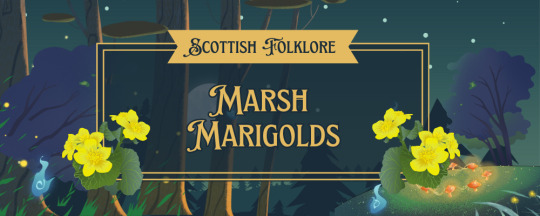
Marsh marigolds(caltha palustris) are known as “lus buidhe Bealltainn,” in Scottish Gaelic, which translates too “the yellow plant of Beltane.”
“Yellow is a colour traditionally connected to prosperity, blessings. Even today we say ‘Nach buidhe dhut!’ – something like ‘Hasn’t a lot of yellow come your way!’ to convey the English expression ‘Aren’t you lucky!’.“
Seaboardgaidhlig
They tend to grow in wet areas; such as bogs, alongside streams, or around ponds.
There is a very short window in spring when the plants are young that they can be cooked to make them safe to eat, but in all other times they are inedible do to toxicity levels.


Despite how toxic they are, the flowers were seen as protective, and were scattered on doorsteps during May Eve, or woven into garland or wreaths to protect homes or barns.
"He took in Lus-buidhe-bealltainn, (marsh marigold) and putting its stalks in the milk turned it to curds and whey. This is said to be the first cheese that was made in Mull."
Waifs and Strays of Celtic Tradition V by Lord Archie Campbell (1889)
They could also be used to help predict the future, such as with this rhyme for foretelling a future marriage, to be spoken while counting the seeds of the plant.
"Silk, satin, muslin, rags,
Boots, shoes, slippers and blowchers
A coach, a gig, a cart, a barrow
A peerie hoose, a muckle hoose, a pigsty, a barn
A cradle, a ladle, a basket, a box
A sojer, a sailor, a tinkler, a tailor,
A plooboy, a pottifer, gentleman, a thief."
Tobar An Duelchai
#folklore#scottish folklore#scottishfolklore#mythology#scottish mythology#fairies#fairy#scottish#fae#scotland#marigolds#marsh marigolds#caltha palustris#beltane#may day
13 notes
·
View notes
Text
“The Ancient Origins of Ouija”
youtube
Join us for a crash course in the history of the Ouija Board.
0 notes
Text
“Prehistoric Irish Monuments Revealed As ‘Pathways for the Dead’”
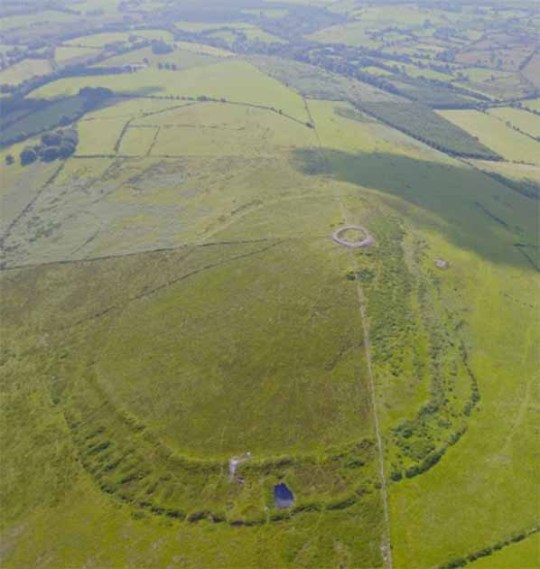
“Positioned strategically within the landscape, these monuments align with burial sites and the cyclical movements of the Sun, marking major solar events like the solstices. Dr. O'Driscoll interprets this alignment as symbolic of the journey of the dead, ascending to the heavens and marking a physical path from the world of the living to the ancestral beyond.”
14 notes
·
View notes
Text
“The side was steep, the bottom deep
Frae bank to bank the water pouring;
And the bonnie lass did quake for fear,
She heard the water-kelpie roaring.”
📖 “Folklore of Scottish Lochs and Springs” by James M MacKinlay (1893)
#folklore#scottish folklore#scottishfolklore#mythology#scottish mythology#fairy#fairies#fae#scotland#scottish#kelpie#kelpies#waterhorse
10 notes
·
View notes
Text

"Pixies dancing in a Ring by the Firelight" by William Bell Scott (1855)
5 notes
·
View notes
Text
New Chapter of Fading of the Veil is up!
This one is a bit short, which was preventing me from posting it, but instead hesitating, I just decided to go for it.
0 notes
Text
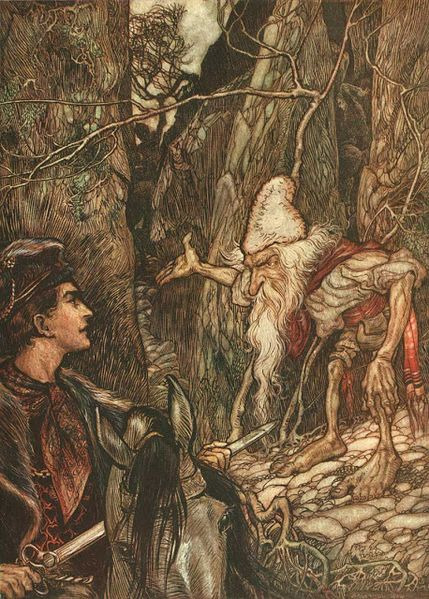
From Grimm's Fairy Tales - Illustrated by Arthur Rackham (1909)
8 notes
·
View notes
Text
New Scottish Folklore Statue

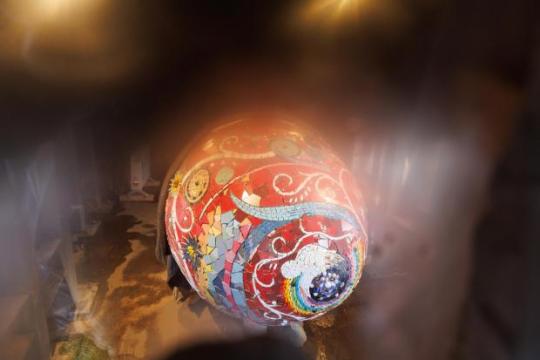
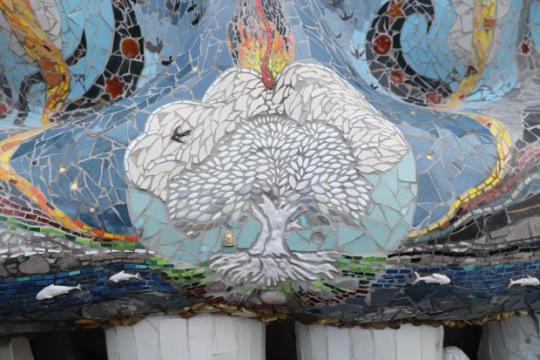
Image source and link with more info
This new Scottish folklore statue, “The Beithir” (AKA Bella) is gorgeous!
A Beithir is a great serpent that was said to love caves and had deadly venom. I have a post on it here if you'd like to learn more:
#beithir#serpent#scottish folklore#scottishm mythology#folklore#mythology#mythological creature#scottish#scotland#glasgow#FairyArt
9 notes
·
View notes
Note
I've been working at Tobar an Dualchais on a short-term basis and I want to say it's brilliant to see you using it as a source! I really love your blog - Scottish folklore gets overlooked so often.
<3
Thank you for your hard work on such a great project! Tobar an Duelchais is a goldmine of knowledge.
(For anyone reading this that needs a reminder: Tobar an Duelchais is an online archive of historical Scottish audio recordings; including about folklore! For example, here is one about a water horse)
I’m glad you like the blog!
9 notes
·
View notes

